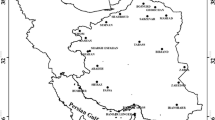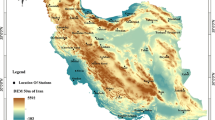Abstract
In order to examine the seasonal characteristics of the dust events over western parts of Iran, surface observations from 27 meteorological stations for the period 1951–2014 were analyzed to obtain spatial distributions and temporal variations and trend of dusty day frequency (DDF). Trends of DDF were analyzed by Mann–Kendall and Sen’s estimator of slope nonparametric statistics. Three meteorological stations were selected in north (Tabriz), middle (Kermanshah), and south of the study area (Ahwaz) as reference stations for detecting the regional differences of DDFs. The results showed that DDF is a variable season by season but in general, DDF increases from north to south and from east to west of Iran. The maximum of DDF is monitored in May, June, and July. There are tangible seasonal increasing–decreasing periods in which these changes are logically related with seasonal changes. Regardless of the existence of the maximum DDF in south and southwest of study area, the most intensive increasing DDF trend is calculated in west middle areas. The most widespread and intensive increasing DDF pattern in west of Iran is observed when it is spring. In this case, the dust storms replaced the rainfalls. Distance from dust sources, major movement ways of dust transporting synoptic systems, regional effective wind activity (such as Shamal wind), and arrangement of high mountains are the known factors affecting frequency variation, distribution, and rate of the trend of all the dust phenomena in west of Iran.






Similar content being viewed by others
References
Abdi Vishkaee F, Flamant C, Cuesta J, Oolman L, Flamant P, Khalesifard HR (2012) Dust transport over Iraq and northwest Iran associated with winter Shamal: a case study. J Geophys Res 117:D03201. doi:10.1029/2011JD016339.
Alijani B (1997) Climatology of Iran. Payame Noor university press, Tehran
Barati GR, Lashkari H, Karami F (2011) The role of pressure systems convergence in occurrence of dust storms in Khuzestan province. J Geogr Dev 22:39–56 [Pressed in Iran]
Cannarozzo M, Noto LV, Viola F (2006) Spatial distribution of rainfall trends in Sicily (1921–2000). Phys Chem Earth 31:1201–1211
Gilbert RO (1987) Statistical methods for environmental pollution monitoring,. van Nostrand Reinhold Company, Inc, New York
Ginoux P, Prospero JM, Torres O, Chin M (2004) Long-term simulation of global dust distribution with the GOCART model: correlation with North Atlantic oscillation. Environ Model Softw 19:113–128. doi:10.1016/S1364-8152(03)00114-2.
Goudie AS, Middleton NJ (1992) The changing frequency of dust storms through time. Clim Chang 20:197–225
Goudie AS, Middleton NJ (2006) Desert dust in the global system. Springer, Heidelberg
Hamidi M, Kavianpour MR, Shao Y (2013) Synoptic analysis of dust storms in the Middle East. Asia-Pac J Atmos Sci 49(3):279–286. doi:10.1007/s13143-013-0027-9.
Huang JP, Minnis P, Lin B, Wang T, Yi Y, Hu Y, Sun-Mack S, Ayers K (2006) Possible influences of Asian dust aerosols on cloud properties and radiative forcing observed from MODIS and CERES. Geophys Res Lett 33
Huang JY, Bristow B, Shafir S, Sorvillo F (2012) Coccidioidomycosis-associated deaths, United States, 1990–2008. Emerg Infect Dis 18(11):1723–1728
IPCC, Intergovernmental Panel in Climate Change, 2007. Climate change 2007: synthesis report. Contribution of working groups I, II and III to the fourth assessment report of the intergovernmental panel on climate change. In: Core writing team, Pachauri, R.K., Reisinger, A.(Eds.). IPCC, Geneva, Switzerland, p. 104.
Jaffe D, Snow J, and Cooper O (2003) The 2001 Asian dust events: transport and impact on surface aerosol concentrations in the US. Eos 84, 501–506.
Juraj MC, Ouarada TBMJ (2009) Trends in the timing and magnitude of floods in Canada. J Hydrol 375:471–480
Karimi N, Moridnejad A, Golian S, Mohammad Vali Samani J, Karimi D and Javadi S (2012) Comparison of dust source identification techniques over land in the Middle East region using MODIS data, Can J Remote Sens, Vol. 38, No. 5, pp. 586–599.
Kendall MG (1975) Rank Auto-correlation Methods, Charles Griffin, London.
Khorshiddoust A M, Mohammadi Gh H, Hosseini Sadr A, Javan Kh and Jamali A (2014) Synoptic analysis of effective factors on dust frequency in west of Iran, J Geog Plan, Vol. 17, No. 46, PP 47–66 [Pressed in Iran].
Khoshkish A, Alijani B, Hejazizadeh Z (2011) Analysis of dust synoptic systems in Lorestan province, J Appl Res Geog Sci, Vol., 18, Pages 91–110[Pressed in Iran].
Kurosaki Y, Mikami M (2002) Seasonal and regional characteristics of dust event in the Taklimakan Desert. J Arid Land Stud 11:245–252
Lashkari H, Keikhosravi Q (2008) Synoptic-statistics analysis of dust storms in Khorasan Razavi provice in the years of 1993 – 2005. Geogr Res, Number 65, pages 17 – 33[Pressed in Iran].
Lim J-Y, Chun Y (2006) The characteristics of Asian dust events in Northeast Asia during the springtime from 1993 to 2004. J Glob Planet Chang 52:231–247
Mann HB (1945) Non-parametric tests against trend. Econometrica 13(245):259
Meskhidze N, Chameides WL, Nenes A (2005) Dust and pollution: a recipe for enhanced ocean fertilization? J Geophys Res 110:D03301. doi:10.1029/2004JD005082.
Middleton NJ (1986) A geography of dust storms in south-West Asia. J Climatol 6:183–196
Prospero JM, Ginoux P, Torres O, Nicholson SE, Gill TE (2002) Environmental characterization of global sources of atmospheric soil dust identified with the nimbus 7 total ozone mapping spectrometer (TOMS) absorbing aerosol product. Rev Geophys 40(1):1002. doi:10.1029/2000RG000095.
Rezazadeh M, Irannejad P, Shao Y (2013) Climatology of the Middle East dust events. Aeolian Res 10:103–109. doi:10.1016/j.aeolia.2013.04.001.
Serrano A, Mateos VL, Garcia JA (1999) Trend analysis of monthly precipitation over the Iberian peninsula for the period 1921-1995. Phys Chem Earth (B) 24(1–2):85–90
Shamsipour AA, Safarerad T (2011) Satellite–synoptic dust phenomena analysis (case study of 2009 dust storms). Phys Geogr Res 79:111–126 [Pressed in Iran].
ShaoY, Klose M, Wyrwoll K-H (2013) Recent global dust trend and connections to climate forcing. J Geophys Res-Atmos 118:11,107–11,118. doi:10.1002/jgrd.50836.
Speer Milton S (2013) Dust storm frequency and impact over Eastern Australia determined by state of Pacific climate system. Weather Climate Extremes 2:16–21. doi:10.1016/j.wace.2013.10.004
Sprigg WA, Nickovic S, Galgiani J N, Pejanovic G, Petkovic S, Vujadinovic M, Vukovic A, Dacic M, DiBiase S, Prasad A and El-Askary H (2014) Regional dust storm modeling for health services: the case of valley fever. Aeolian Res 14, PP 53–73, doi.org/10.1016/j.aeolia.2014.03.001.
Tavoosi T, Khosravi M, Raeispour K (2010) Analysis of dust synoptic systems in Khuzestan province. J Geogr Dev 20:97–118 [Pressed in Iran]
Turgay P and Ercan K (2005) Trend analysis in Turkish precipitation data. Hydrological processes published online in Wiley Inter Science (www.Interscience.wiley.com).
Topaloglu F (2006) Regional trend detection of Turkish river flows. Nord Hydrol. 37(2), 165–182.
Varga G (2012) Spatio-temporal distribution of dust storms—a global coverage using NASA TOMS aerosol measurements, Hungarian Geographical Bulletin. 61(4):275–298
Vicente d P (2004) On climate variability in northeast of Brazil. J Arid Environ 58:575–596
Winton V H L, Dunbar GB, Bertler NAN, Millet MA, Delmonte B, Atkins CB, Chewings JM and Andersson P (2014) The contribution of aeolian sand and dust to iron fertilization of phytoplankton blooms in southwestern Ross Sea, Antarctica. Glob Biogeochem Cycles, 28, 423–436, PP 423–436, DOI: 10.1002/2013GB004574.
WMO, World Meteorological Organization (1974) Manual on Codes, vol. I. International codes. WMO Publ., Geneva.
Xu J (2006) Sand-dust storms in and around the Ordos Plateau of China as influenced by land use change and desertification. Catena 65:279–284
Yu H, Chin M, Yuan T, Bian H, Remer LA, Prospero JM, Omar A, Winker D, Yang Y, Zhang Y, Zhang Z and Zhao C (2015) The fertilizing role of African dust in the Amazon rainforest:A first multiyear assessment based on data from Cloud-Aerosol Lidar and Infrared Pathfinder Satellite Observations. Geophysical Research Letters, 42, doi:10.1002/2015GL063040.
Zolfaghari H, Aabedzadeh H (2005) Analysis of dust synoptic systems in west of Iran. Journal of Geography and Development, PP 173–187 [Pressed in Iran].
Author information
Authors and Affiliations
Corresponding author
Rights and permissions
About this article
Cite this article
Sarraf, B.S., Rasouli, A.A., Mohammadi, G.H. et al. Long-term trends of seasonal dusty day characteristics—West Iran. Arab J Geosci 9, 563 (2016). https://doi.org/10.1007/s12517-016-2589-1
Received:
Accepted:
Published:
DOI: https://doi.org/10.1007/s12517-016-2589-1




